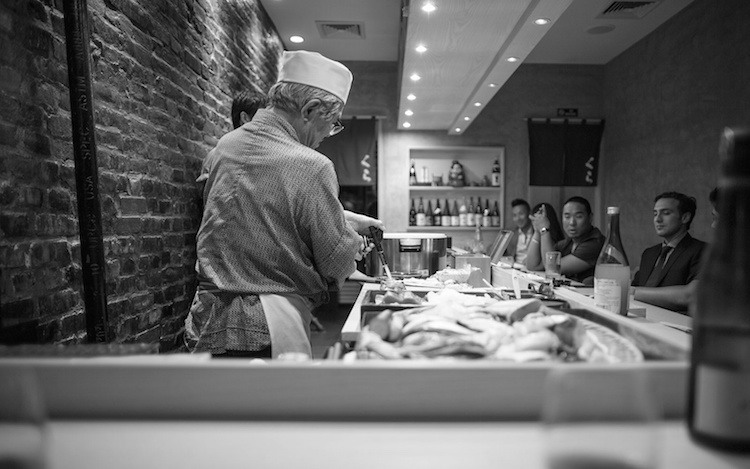
Omakase, One Thing, Done Really Well
Kura is a nondescript sushi restaurant on New York City’s Lower East Side. The restaurant has no sign, and it shares an address with the pizza restaurant next door. It’s as if they’re asking passersby not to come in. While that may seem like a counterintuitive business strategy, it makes sense for Kura. High-end omakase-only (“I’ll leave it up to you” in Japanese) sushi restaurants aren’t really meant for passersby. They’re for people willing to pay $150 or more per person for exquisitely prepared raw fish. While this has become a much more common occurrence in recent years, whether it be because of the rise of food culture or documentaries like Jiro Dreams of Sushi, the fact still remains that consumption at this level is reserved for a select few or on special occasions.
For those with less knowledge of sushi consumption, it breaks down into the following categories: neighborhood, branded, and omakase.
Neighborhood sushi spots are your lower-cost, traditional restaurants serving a standard selection of traditional sushi pieces, American-style sushi rolls like spicy tuna and California, and an assortment of hot Japanese dishes such as edamame, chicken teriyaki, and assorted tempuras. These restaurants are generally hit or miss. While you may love your go-to spot, it’s more for its consistency, pricing, and excessive use of spicy mayo, not its transcendent greatness. That’s what happens when Americans reinterpret a global cuisine for mass consumption: We’re the bastardization nation.
The next level, trendy branded sushi restaurants, can be one-off restaurants but generally are parts of a restaurant chain. Some of the brands you’d recognize in this category are Nobu, SushiSamba, Zuma, TAO, Megu, Pubbelly, and Haru. Their prices range from fifty- to two-hundred-dollars per person, depending on your consumption of alcohol and upsell specials like Kobe beef or king crab. These restaurants are as much about their vibe as they are about the food and the need to serve mass quantities of people to pay for high overhead. Therefore, the best items are the ones they sell the most of, the signatures, like Black Cod with Miso, Yellowtail Sashimi with Jalapeño, and Spicy Tuna on Crispy Rice. Most importantly, like most things in modern life, it isn’t about excellence, it’s about consistency. Meeting or exceeding expectations over time.
Kura falls into the third category of sushi restaurant, the one you’ll find most often in Japan, omakase. While not all sushi bars of this type require omakase, the most notable focus on providing an exquisite interpretation the classic Japanese omakase. This is where a trained sushi chef takes you on a journey by curating and preparing the best product available, sort of like a great musician and their instrument. Over the past decade or so, this type of sushi has begun to proliferate throughout American cities, a reflection of consumers shifting preferences to be closer to the makers, the desire for true craftsmanship. Los Angeles has been well-known for this type of sushi for years; in New York, Masa would be the most well-known and expensive, but the offerings range from the more commercialized, like the west coast import SUGARFISH, the locals Gari, and Seki, and the more boutique and truly special, like Kura and Inoue (CLICK HERE FOR A LIST OF THE BEST SUSHI IN NYC). My rule of thumb is, the smaller and more traditional the restaurant, the less volume being prepared and served; the more likely you’ll encounter greatness. At Kura, on a rainy night in May, I encountered greatness.
As Americans, we have few professionals that compare with a master sushi chef, and few experiences that compare with a true one-on-one omakase meal. The chef trains for decades to perfect his craft. His tools are few: the rice, the fish, a knife, his hands, a brush, soy sauce, and, occasionally, a handheld flame. He knows them intimately. He has no interest in figuring out ways to mass manufacture; every meal, every piece, is a work of art designed to amplify the natural flavors of the ingredients. The aim is mastery, one thing, done really well. And the result, when delivered by a master, as at Kura, is beyond expectation.
Great omakase sushi is like nothing else.
In the modern world, we get pulled in a myriad of directions; while we may desire mastery, inevitably the manifestation of our purpose, our work, is diluted by lack of focus and time. But the financial and spiritual reward for doing less, for focusing on what makes you great and becoming a master is actually far greater over the long term. Like the master sushi chef, to unlock your full potential you must pursue your purpose and perfect your craft. When you do, you’ll enjoy a level of fulfillment far beyond your expectations.
CLICK HERE FOR MORE INFO ON KURA

